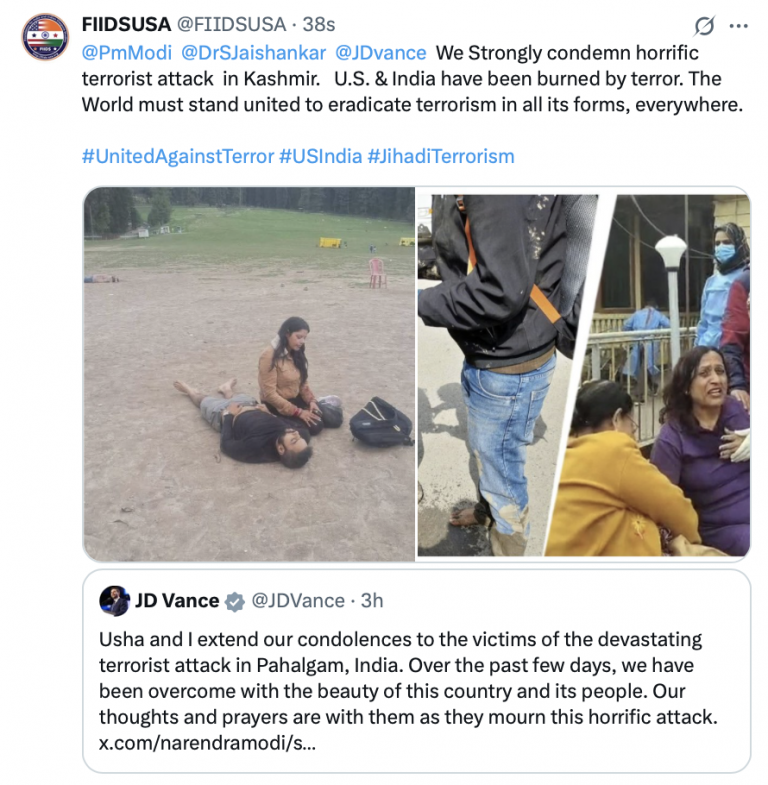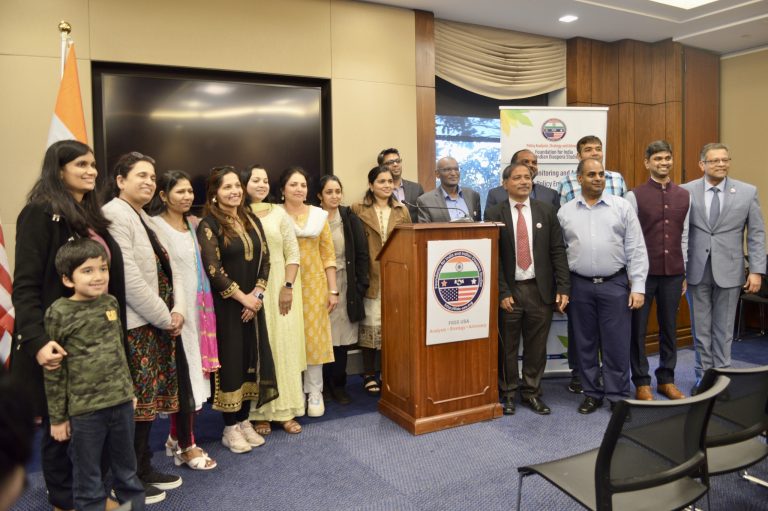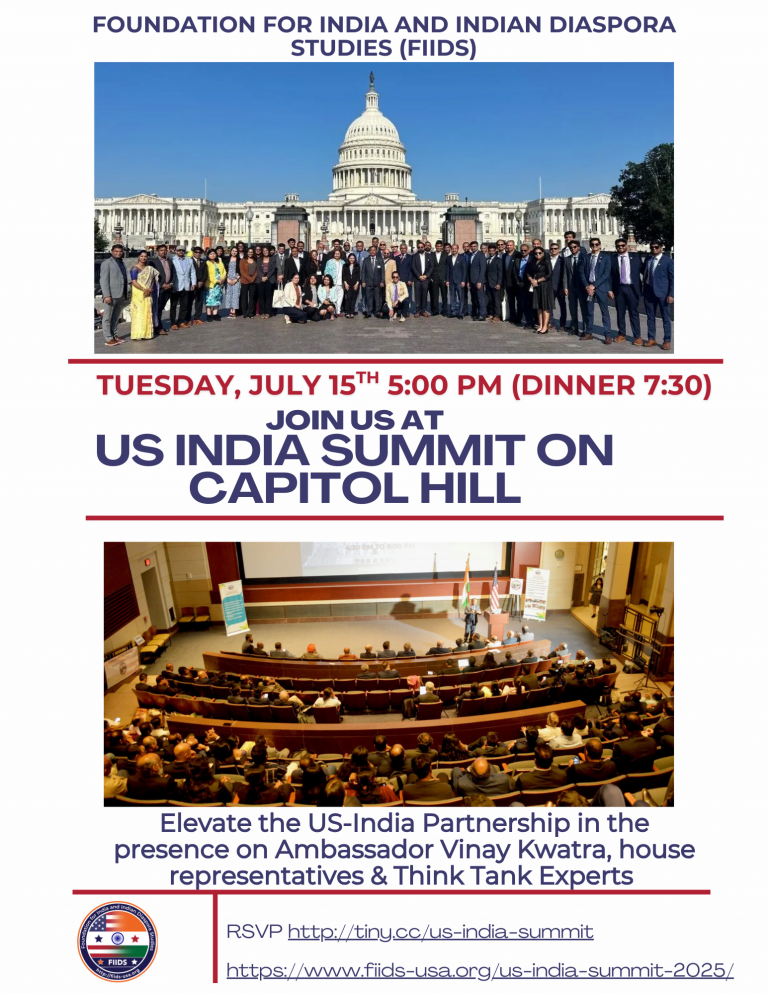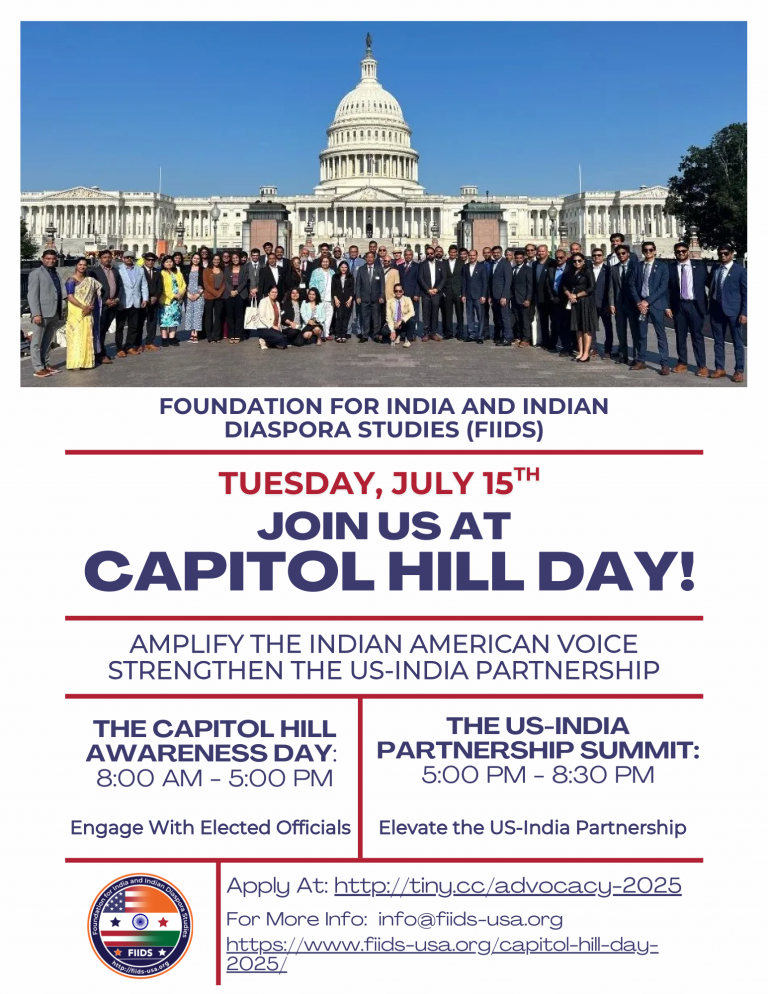
Nov 9th, 2019
The Foundation for India and Indian Diaspora Studies USA (FIIDS) thanks to the Supreme Court(SC) of India for delivering a historic verdict on Ayodhya Ram Temple, one of the most sensitive issues of India. FIIDS admire the Supreme Court for conducting hearing the Ayodhya case non-stop for the last 40 days to resolve this difficult case that had been pending for the last seven decades.
The SC considered archeological, government records and historical evidence to deliver this verdict upholding the Hindu belief that the Ram Janma (Birth) Bhoomi temple existed before the disputed structure. We welcome a well-balanced verdict that the SC handed over the entire land to Hindus and allocated land for a mosque.
This balanced judgment sets precedent for all future disputes and shows the maturity of the Indian judicial system to resolve challenging situations in a calm, collected and fair manner. We observe that Modi Government, various state government and socio-political leaders from all communities of India are trying to maintain law and order.
Highlights of the verdict:
The Supreme Court recognized the deity Ram Lalla’s title rights to the disputed 2.77-acre Ayodhya land and directed the government that a trust be set up within three months to manage the land’s affairs for the reconstruction of a Ram temple. The Supreme Court also directed that the Sunni Waqf Board be given five acres of land in Ayodhya for the construction of a mosque.
Evidence Considered in the Ruling:
- The Supreme Court considered Archaeological Survey of India (ASI) report to observe that the Babri Masjid was not built on vacant land and that there was evidence of a temple-like structure that existed on the land before the mosque was built.
- The Supreme Court also said that the faith of the Hindus that Lord Ram was born at the disputed site where the Babri Masjid once stood cannot be disputed.
- The Supreme Court said that the UP Sunni Central Waqf Board has failed to establish its case in Ayodhya dispute case and Hindus have established their case that they were in possession of outer courtyard of the disputed site.
The Foundation for India and Indian Diaspora Studies (FIIDS) is a policy, advocacy and awareness forum for India and Indian diaspora related issues. For information please contact khanderao@fiids-usa.org
Appendix 1 Brief Legal History of the Case:
1529: Ram Mandir was destroyed and Babri Mosque constructed by Mir Baqi, a general of Babur, on a direction from Babur.
1885: Court Dispute Begins – Mahant Raghubir Das files the first suit in the matter, seeking to build a temple on land adjoining the mosque. The Faizabad District Magistrate (DM) refuses him permission. Next, Mahant Raghubir Das files a title suit in Faizabad Court against the Secretary of State for India, seeking permission to build a temple on the chabutra (courtyard) of the Babri mosque. Faizabad Court rejects his plea.
1949: Ram Idol Appears inside the Mosque – On the night of 22nd December, a Ram Idol appears inside the mosque. Hindus see the appearance of the Idol as a divine revelation, however many argue that the Idol was smuggled inside at night. Hindus start offering prayers.
The Government declares the site as a “contested area” and locks the entrance.
1950: Hindu sides file Suits – Two suits are filed in Faizabad Court by Gopal Simla Viharad and Paramhansa Ramachandra Das, seeking permission to conduct Hindu pujas to Ram Lalla. The Court granted the parties permission to conduct pujas. The Court orders the inner courtyard gates to remain locked.
1959: Third Hindu suit filed – Nirmohi Akhara files third suit, seeking possession of the land.
1961: Muslim suit filed – UP Sunni Wakf Board files a suit seeking possession of Babri Mosque site. They also demand the removal of Ram Idols from Babri Masjid.
1975:
1984: Ram Janmabhoomi Movement commences – Vishwa Hindu Parishad (VHP) constitutes a group to start the Ram Janmabhoomi Movement. BJP leader LK Advani is made the leader of the campaign.
1986: On February 1st, 1986, Inner Gate of Babri Mosque opened – A third party, lawyer UC Pandey appeals for the gates to be unlocked before the Faizabad Session Court, on the grounds that the Faizabad district administration, and not a Court, had ordered its closure.
District Judge orders the locks to be removed to allow Hindu “pooja and darshan”. Muslims constitute a Babri Mosque Action Committee (BMAC) in protest.
1975 – 1980: Professor B. B. Lal conducts extensive Archeological Survey – In the period 1975-80, the Archaeological Survey of India undertook a project to study the various sites mentioned in the Ramayana. The combined evidence shows that there did exist a historical basis for the Ramayana. Excavations were also done at two places around the Babri structure. They established the existence of pillar bases outside the structure, which were aligned in the same direction as the pillars in the structure, and the distance between the bases outside and the pillars inside were the same. These excavations also showed that the site was occupied prior to 7th century BC, that is for nearly 3000 years. The pillars that were present in the Babri structure had distinctive Hindu features, establishing the existence of a temple prior to the construction of the Babri structure.
1989: Shilanayas performed – On November 9th, 1989, Prime Minister Rajiv Gandhi allows the VHP to perform Shilanayas (laying of foundation stone) near disputed area.
1989: All title suits shifted to Allahabad High Court. Another suit in the name of Ram Lalla Virajman filed in the High Court, naming the parties in the Nirmohi Akhara (1959) and Sunni Waqf Board (1961) suits as defendants.
1990: Rath Yatra – On September 25th, 1990LK Advani launches a Rath Yatra from Somnath (Gujarat) to Ayodhya (UP) to incite support for the Movement. Communal riots break out.
1992: Babri demolished – On December 6th, 1992, Babri Mosque is razed by Karsevaks. The Karsevaks leave behind a make-shift temple in its place.
1992: Liberhan Commission formed – On December 16, 1992, ten days after the Mosque was demolished, the PM forms a committee led by retired High Court Judge M. S. Liberhan, to look into circumstances leading to the demolition of the Babri Mosque and the communal riots. The Commission was originally mandated to submit its report within three months of its formation.
1993: State acquires Ayodhya land – On January 7th, 1992, Prime Minister Narsimha Rao’s Government issued an ordinance acquiring 67.7 acres of land (Site and adjoining areas). Later it was passed as a law – Acquisition of Certain Area at Ayodhya Act, 1993 to facilitate acquisition of land by Central government
1994: Ismail Faruqui Judgment – The SC by a majority of 3:2 upheld the constitutionality of Acquisition of Certain Areas at Ayodhya Act.
The majority judgment by former CJI JS Verma reasoned that every religious immovable property is liable to be acquired. The SC adjudged that offering namaz at mosque was not integral to Islam unless that mosque had any particular significance in Islam. The judgment has been criticized for regarding the mosque as a non-essential place of worship.
There were no reviews filed against Ismail Faruqui
2002: Ayodhya Title Dispute case begins – In April 2002, The Lucknow Bench of the Allahabad High Court begins hearing Ayodhya Title Dispute.
March – August 2003: ASI Survey: – Archaeological Survey of India begins excavating the land underneath the disputed site on the directions of the Allahabad High Court. It claims to have found remnants of a 10th century Hindu Temple. Muslims question the ASI report.
2009: Liberhan Commission report submitted – After a delay of 17 years, on June 30th, 2009, The Librehan Commission submits its report to the Prime Minister, though its contents are not made public.
2010: Allahabad HC splits land in three ways – On September 30th, 2010, The High Court delivers its judgment, dividing the land between three parties: one third for the Sunni Wakf Board, one third for the Nirmohi Akhara and one third to Ram Lalla Virajman.
The judgment of the Lucknow Bench of the HC of September 30, 2010, which divided the disputed land in Ayodhya in 2:1 ratio among the Muslim and Hindu litigants.
The HC allotted the dome of the demolished Babri Masjid, under which the makeshift temple currently stands, to the Hindus. The structure was demolished by a group of Karsevaks on December 6, 1992. The nearby Ram Chabutra and Sita Rasoi also went to the Nirmohi Akhara. The one-third share of the Sunni Wakf Board comprise the outer courtyard of the disputed land.
2011: Supreme Court stays Allahabad High Court ruling – In May 2011, The Supreme Court admits a batch of petitions filed by all parties. A Division Bench of Justices Aftam Alam and R.M. Lodha term the High Court Judgment as “strange”. RM Lodha observer “a new dimension has been given by the High Court as the decree of partition was not sought by the parties. It was not prayed for by anyone. It has to be stayed. It’s a strange order. How can a decree for partition be passed when none of the parties had prayed for it?..”
2017: Former Chief Justice Khehar, on March 21s1, 2017, suggests an out of court settlement among all parties.
2017: Three judge bench of SC starts hearing the matter – On August 11th, 2017, The 3 judge bench of SC comprising CJI Dipak Misra, Justices Ashok Bhushan and Abdul Nazeer began hearing the appeal.
Feb – July 2018: The petitioners argue that the SC ought to refer the 1994 Ismail Faruqui judgment to a 7-judge Bench for reconsideration.
2018: Supreme Court reserves verdict – On July 20th, 2018, The SC reserves judgment on the question of referring the appeal to a larger Bench
2018: Supreme Court refuses to form a larger Bench – On September 27th, 2018, The three judge bench in a split of 2:1 verdict held that the Ismail Faruqui judgment of 1994 does not require reconsideration by a larger bench.
2019: Chief Justice of India (CJI) Ranjan Gogoi forms a five judge Bench – On January 8th, 2018, CJI Gogoi used his administrative powers to list the matter before a five judge Constitution Bench, overturning the September 2018 judgment.
2019: Supreme Court orders mediation – After 2 days of hearing, on March 8th, 2019, the Constitution Bench orders court-monitored mediation, despite the objection of some key parties. The mediation is set to end in mid May 2019.
Appendix 2 : History of Hindu Struggle:
There have been 77 attempts to regain control of Ram Janmabhoomi. With 4 attempts during the time of Babur, 10 during Humayun’s rule, 30 when Aurangzeb was on the throne, 5 when Shahadat Ali was the ruler, 3 during the time of Nasir-ud-din Haider, 2 during British rule and once post independence.
Ram Janma Bhoomi Movement:
Dharma Sansad: As the VHP joint general secretary, in 1984 Ashok Singhalji organised the first “dharam sansad” and mobilized saints and seers in support of the Ram temple issue. Under his leadership, Ram Janma Bhumo Andolan was launched.
Ram Shila Pooja: During September and October, VHP/RSS organized a country wide campaign to perform Ram Shila(brick) pooja at 297,705 places. This campaign culminated in a shilanyas in Ayodhya on Nov 9th 1989 when a dalit man performed the shilanyas(laying foundation stone) for the temple construction.
Rath Yatra: In 1989 Bharatiya Janata Party added Ram Janma Bhoomi in its manifesto for the upcoming election. From September to October 1990, Advani stirred India with Ram Rath Yatra (chariot journey – in a truck) traversing 300 kms of India from Somanath to Ayodhya with average 6 rallies per day. Though he was arrested on 23rd October on the border of Uttar Pradesh, thousands of Karsevaks reached Ayodhya followed by Hindu Muslim riots in which about 2000 died.
First KarSeva: Decision of starting Karsewa (religious duties) for construction of the temple was taken in a meeting of the Margadarshak Mandal held at Haridwar on 23-24 June 1990. Mulayam Singh Yadav’s Govt. opened fire and massacred Karsewaks(devotees) in the narrow lanes and bye-lanes of Ayodhya leading to Hanuman Garhi from Digambar Akhada on 02 November 1990.
Land Acquisition: The then Chief Minister Shri. Kalyan Singh acquired 2.77 acres of land surrounding the disputed structure on 10 October 1991 barring the structure for developing facilities for the pilgrims.
Demolition: The Dharma Sansad held in Delhi on 30 October 1992 announced ‘06 December’ as the Day for beginning of fresh Karsewa. The Uttar Pradesh Govt had also requested the Supreme Court on 25th November to issue orders to the Lucknow Bench of Allahabad High Court to pronounce its judgement kept reserved by it. Accordingly, the Supreme Court had issued the directives too; but the High Court declared the date for pronouncement of the judgement as 11 December. This announcement made 150,000 karsevaks impatient who became out of control and destroyed the disputed structure on 6th December 1992.






